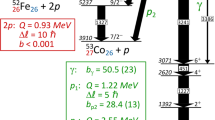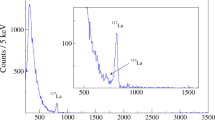Abstract
IT has recently been shown by Lea1 that the passage of neutrons through paraffin wax and through liquid hydrogen gives rise to a gamma radiation of 1–6 × 106 e. volts energy, as well as recoil protons. As pointed out by Lea and Chadwick, the energy of these rays corresponds roughly to that which would be emitted in the radiative combination of a neutron and a proton to form a diplon. We have therefore calculated the probability of such a radiative collision on the assumption that the neutron behaves as a fundamental charge-free particle throughout the collision, so that the radiation arises only from the acceleration of the proton by the field of force of the neutrpn. A dipole moment may then be associated with the system and the calculation carried out in the usual manner2. The result is that, for the range of energies involved in the experiments, combination should not take place more frequently than once in every 1000 collisions (the effective radius for diplon formation is about 2 × 1014 cm.). This is much smaller than the observed frequency of about 1 in 4 collisions. We have also calculated the probability of a proton radiating in the impact without binding taking place, and find it to be even smaller. These results do not depend appreciably on the form of interaction assumed between neutron and proton.
This is a preview of subscription content, access via your institution
Access options
Subscribe to this journal
Receive 51 print issues and online access
$199.00 per year
only $3.90 per issue
Buy this article
- Purchase on SpringerLink
- Instant access to full article PDF
Prices may be subject to local taxes which are calculated during checkout
Similar content being viewed by others
References
NATURE, 133, 24, Jan. 6, 1934.
Mott and Massey, "The Theory of Atomic Collisions", p. 229.
Z. Phys., 77, 1 ; 1932.
Mott and Taylor, Proc. Roy. Soc., A, 138, 665 ; 1932.
Author information
Authors and Affiliations
Rights and permissions
About this article
Cite this article
MASSEY, H., MOHR, C. Radiative Collisions of Neutrons and Protons. Nature 133, 211 (1934). https://doi.org/10.1038/133211a0
Issue date:
DOI: https://doi.org/10.1038/133211a0



